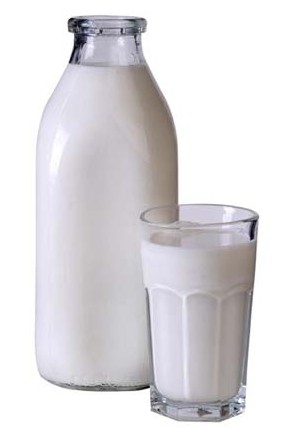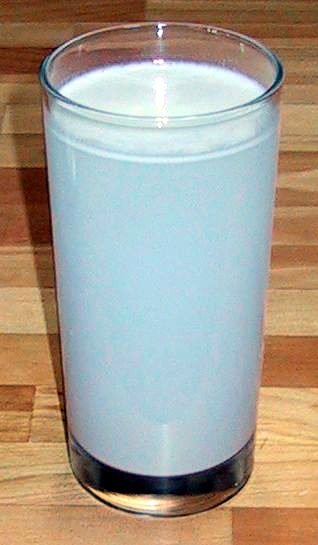Why Milk is White
 Today I found out why milk is white.
Today I found out why milk is white.
Milk is made up of about 87% water and 13% solids, such as fat and various proteins. Chief among these proteins is something called casein, four types of which make up about 80% of the proteins in milk. The casein protein molecules are typically suspended somewhat uniformly throughout the milk and are spherical, about a micrometer across. The reason they are typically somewhat uniformly suspended in the liquid is because kappa-casein molecules have a negative electrical charge, so they repel each other.
White objects in nature appear such when there is some level of light diffusion going on and no part of the visible spectrum gets reflected off the object any more than any other part of that area of the light spectrum. So as you might guess from that, these casein proteins and some of the fats in the milk scatter and deflect light somewhat uniformly throughout the visual spectrum. This results in milk being fairly opaque and appearing white to our eyes. Without the fats though, casein itself tends to scatter the blue wavelength slightly more than red. So with something such as fat free skimmed milk, you’ll sometimes see a very slight blue-ish tinge to the otherwise white milk because of this.
Milk also contains riboflavin, which can give the milk a slightly green-ish tinge, if the concentration is large enough, such as can also be seen sometimes in certain types of skimmed milk or whey products (the riboflavin is in the whey portion of the milk).
Another hue you’ll occasionally see in milk is a slight yellow color. When you see this, it is due to small amounts of carotene that are present in the milk. You will see this particularly in milk from Guernsey and Jersey cattle.
If you liked this article and the Bonus Facts below, you might also enjoy:
- MLB Superstar Justin Verlander in High School Traded a Small Percentage of His Eventual $3.12 million Signing Bonus for a Chocolate Milk
- What Causes Lactose Intolerance
- The History and Origin of Cheese
- Why Chocolate is Bad for Dogs
- The History and Origin of Ice Cream
Bonus Facts:
- This scattering of blue more than red, is as a result of the Tyndall effect and is also the same reason sometimes smoke from car or motorcycle exhaust appears slightly blue when certain types of engine oil are burned. The Tyndall effect is the scattering of light by particles in a very fine suspension in some substance, also known as a colloid. Specifically, the shorter wavelength light ends up getting scattered more than the longer wavelengths of light.
- Until Newton’s work on light, the prevailing opinion was that white was a fundamental color of light and you got other colors by adding something to the white. Newton proved this to be false by showing that white light is simply the effect of combining all colors in the visible spectrum equally, using two prisms to demonstrate this fact.
- White paints are typically made by providing a very fine transparent material with a high refractive index that is in turn suspended in some sort of a binding agent. The typical substance used for this is calcium carbonate or a synthetic form of rutile.
- Holstein cows comprise about 85%-90% of all dairy cows in the United States and Europe.
- Human milk produced early in lactation, called colostrum, carries antibodies from the mother to the baby, which drastically strengthens the baby’s immune system.
- About 40% of a cow’s milk’s calories are from lactose. Lactose is a composite of glucose and galactose.
- Lactose intolerance is caused by a lack of the enzyme lactase, which resides in the small intestine. Once a baby is born, their lactase levels slowly diminish unless milk is consumed on a regular basis. When the lactose is passing through your small intestine, it will become attached to the lactase and then the galactose and glucose from the lactose can be absorbed. Without the lactase, this can’t happen, which can then cause diarrhea, intestinal gas, cramps, etc.
- The intestinal gas from undigested lactose is caused by microflora in your intestines processing the lactose and excreting gas through anaerobic respiration.
-
Milk from a non-human source has been used by humans since at least 6,500 BC, based on a finding of pottery from around that era in Turkey which contained byproducts of non-human milk. Before that find, it was thought that humans of that era had not yet developed the digestive ability to process non-human milk.
- Grade A and Grade B milk are the two varieties allowed in the United States. Grade A milk is used for direct consumption. Grade B milk is used for making cheeses and other types of milk product. There is very little difference between the two; Grade A milk is cooled using refrigeration (due to the requirement to keep it at 45 F within two hours of milking) and Grade A milk farms are inspected every six months. Grade B milk is typically cooled in cans immersed in cold flowing water underground (same temperature of 45 F). Grade B milk farms, though, only need inspected every two years. There are also a few differences in terms of bacterial count and things of this nature, but this isn’t a significant difference when factoring in eventual pasteurization and the like of milk sold to be drunk.
- The pasteurization process that kills microorganisms in milk, also destroys the Vitamin C content, as well as significantly diminishes various other health benefits of milk.
- Milk is also generally homogenized, which is where the milk is forced through high pressure, narrow tubes to break down fat globules. This ultimately keeps the cream layer from separating from the rest of the milk. It also has been linked to various health related problems with milk, although the homogenized milk is easier for humans to digest. The homogenization process also must not be done until after the pasteurization process because many of the enzymes in the milk before pasteurization would break down the smaller globules of fat, resulting in the milk turning rancid. The pasteurization process neutralizes these enzymes, stopping that from happening.
- A newer process has been developed, which has proven superior to pasteurization, called microfiltration. First, the cream is separated from the whey, as it cannot be properly filtered. Next, the whey is forced through ceramic microfilters that trap 99.9% of all microorganisms. This is approximately 5% better than can be done with conventional pasteurization; this better filtration extends the shelf life of the milk significantly. Next, the cream is pasteurized in the normal way and then recombined with the whey to result in the same composition of whey/cream as before the microfiltration.
- The reason raw milk goes bad, at least for drinking purposes, so quickly when left out is that the lactose in the milk ends up getting processed by microorganisms into lactic acid. Depending on the microorganisms doing the processing, this can produce a variety of tasty products, such as various types of cheeses, yogurts, buttermilk, etc.
- Pasteurizing milk ends up destroying many of these types of bacteria that produce lactic acid. As a result, the milk cannot properly ferment, which allows other types of microorganisms to thrive. This can eventually cause food poisoning. This typically doesn’t happen in raw milk because the fermentation process by the lactic acid producing bacteria significantly slows the “bad” microorganisms from growth rate. So we get cheese and the like from fermented raw milk, instead of food poisoning like in pasteurized milk that is left out.
- Milk pasteurized using ultra high temperature treatments can be stored for several months without refrigeration, so long as it remains unopened. This also alters the taste of the milk slightly, which is why it is not the preferred pasteurization process.
- Casein’s molecular structure is very similar to that of gluten. This is why many gluten free diets also are casein-free.
| Share the Knowledge! |
|






5 comments